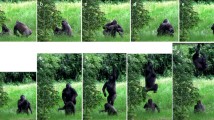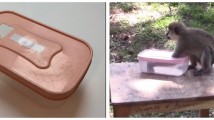Abstract
An individual’s foraging activity can be influenced by the choices made by nearby conspecifics. The interest shown in the location and characteristics of a feeding patch may depend on the feeding success of a conspecific there, a process that needs to be distinguished from choices guided by rewards to the observer itself. We investigated how rewards for both self and others influence the foraging choices of captive capuchin monkeys (Cebus apella). Thirteen adult capuchins observed familiar female conspecific models explore one of three opaque boxes under three conditions. In the first, there were no rewards available to either monkey; in the second, rewards were available to the model only; and in the third, both monkeys could retrieve a reward. Under all conditions, subjects more often explored the same box as the model than was expected by chance. Thus, without ever receiving a reward themselves or without seeing another receive rewards, subjects’ searches were directed at the box explored by another monkey. The tendency to match the model’s choice increased if the subject was rewarded. We compared these results to control conditions in which the model was either absent, or present but not allowed to demonstrate. Subjects’ located the reward less often in control conditions, than in the experimental conditions. We conclude that extrinsic rewards, while helpful, are not required for partners to influence the foraging choices of capuchins, and that the unrewarded copying of foraging choices demonstrated here may provide the basis for additional social influences on learning.


Similar content being viewed by others
References
Adams-Curtis L, Fragaszy DM (1995) Influence of a skilled model on the behavior of conspecific observers in tufted capuchin monkeys (Cebus apella). Am J Primatol 37:65–71
Akins CK, Zentall TR (1998) Imitation in Japanese quail: the role of reinforcement of demonstrator responding. Psychon B Rev 5:694–697
Bandura A (1977) Social learning theory. Prentice-Hall Inc., Englewood Cliffs
Bjorklund DF, Bering JM (2003) A note on the development of deferred imitation in encultured juvenile chimpanzees (Pan troglodytes). Dev Rev 223:389–412
Bonnie KE, de Waal FBM (2006) Affiliation promotes transmission of a social custom: handclasp grooming among captive chimpanzees. Primates 47:27–34
Brosnan SF, de Waal FBM (2003) Monkeys reject unequal pay. Nature 425:297–299
Brosnan SF, de Waal FBM (2004) Socially learned preferences for differentially rewarded tokens in the brown capuchin monkey, Cebus apella. J Comp Psychol 118:133–139
Caldwell CA, Whiten A (2002) Evolutionary perspectives on imitation: is a comparative psychology of social learning possible? Anim Cogn 5:193–208
Coussi-Korbel S, Fragaszy DM (1995) On the relation between social dynamics and social learning. Anim Behav 50:1441–1453
Cunningham E, Janson C (2007) A socioecological perspective on primate cognition, past and present. Anim Cogn. doi:10.1007/s10071-007-0078-3
Custance D, Whiten A, Fredman T (1999) Social learning of an artificial fruit task in capuchin monkeys (Cebus apella). J Comp Psychol 113:13–23
Darby CL, Riopelle AJ (1959) Observational learning in the rhesus monkey. J Comp Physiol Psychol 52:94–98
Fawcett TW, Skinner AMJ, Goldsmith AR (2002) A test of imitative learning in starlings using a two-action method with an enhanced ghost control. Anim Behav 64:547–556
Fragaszy DM, Visalberghi E (2001) Recognising a swan: socially-biased learning. Psychologia 44:82–98
Fragaszy DM, Visalberghi E (2004) Socially biased learning in monkeys. Learn Behav 32:24–35
Galef BG (1992) The question of animal culture. Hum Nat 3:157–178
Galef BG, Manzig LA, Field RM (1986) Imitation learning in budgerigars: Dawson and Foss (1965) revisited. Behav Process 13:191–202
Heyes CM, Jaldow E, Dawson GR (1993) Observational extinction: observation of nonreinforced responding reduces resistance to extinction in rats. Anim Learn Behav 21:221–225
Inoue-Nakamura N, Matsuzawa T (1997) Development of stone tool use by wild chimpanzees (Pan troglodytes). J Comp Psychol 111:159–173
Janson CH, van Schaik CP (1993) Ecological risk aversion in juvenile primates: slow and steady wins the race. In: Pereira ME, Fairbanks LA (eds) Juvenile primates. Oxford University Press, New York, pp 57–74
Lonsdorf EV, Eberly LE, Pusey AE (2004) Sex differences in learning in chimpanzees. Nature 428:715–716
Matsuzawa T, Biro D, Humle T, Inoue-Nakamura N, Tonooka R, Yamakoshi G (2001) Emergence of culture in wild chimpanzees: education by master-apprenticeship. In: Matsuzawa T (ed) Primate origins of human cognition and behavior. Springer, Tokyo, pp 557–574
Miklosi A (1999) The ethological analysis of imitation. Biol Rev 74:347–374
Nagell K, Olguin RS, Tomasello M (1993) Process of social learning in the tool use of chimpanzees (Pan troglodytes) and human children (Homo sapiens). J Comp Psychol 107:174–186
Nicol CJ (1995) The social transmission of information and behavior. Appl Anim Behav Sci 44:79–98
Ottoni EB, Mannu M (2001) Semi-free ranging tufted capuchins (Cebus apella) spontaneously use tools to crack open nuts. Inter J Primatol 22:347–357
Ottoni EB, de Resende BD, Izar P (2005) Watching the best nutcrackers: what capuchin monkeys (Cebus apella) know about others’ tool-using skills. Anim Cogn 8:215–219
Palameta B, Lefebvre L (1985) The social transmission of a food-finding technique in pigeons: what is learned? Anim Behav 33:892–896
Prescott MJ, Buchanan-Smith HM, Smith AC (2005) Social interaction with non-averse group-mates modifies a learned food aversion in single- and mixed-species groups of tamarins (Saguinus fuscicollis and S. Labiatus). Amer J Primatol 65:313–326
van Schaik CP (2003) Local traditions in orangutans and chimpanzees: social learning and social tolerance. In: Fragaszy DM, Perry S (eds) The biology of traditions. Cambridge University Press, Cambridge, UK, pp 297–328
van Schaik CP, Ancrenaz M, Borgen G, Galdikas BMF, Knott CD, Singleton I et al (2003) Orangutan cultures and the evolution of material cultures. Science 299:102–105
Skinner BF (1950) Are theories of learning necessary? Psychol Rev 57:193–216
Snowdon CS, Boe CY (2003) Communication about unpalatable foods in tamarins (Saguinus oedipus). J Comp Psychol 117:142–148
Spence KW (1937) The differential response in animals to stimuli varying in a single dimension. Psychol Rev 44:430–444
Valone TJ, Templeton JJ (2002) Public information for the assessment of quality: a widespread social phenomenon. Philos Trans 357:1549–1557
Visalberghi E, Addessi E (2001) Acceptance of novel foods in capuchin monkeys: do specific social facilitation and visual stimulus enhancement play a role? Anim Behav 62:567–576
Visalberghi E, Addessi E (2003) Food for thought: social learning about food in capuchin monkeys. In: Fragaszy DM, Perry S (eds) The biology of traditions. Cambridge University Press, Cambridge, UK, pp 187–212
de Waal FBM (1997) Food transfers through mesh in brown capuchin monkeys. J Comp Psychol 111:370–378
de Waal FBM (1998) No imitation without identification. Behav Brain Sci 21:689
de Waal FBM (2000) Attitudinal reciprocity in food sharing among brown capuchin monkeys. Anim Behav 60:253–261
de Waal FBM (2001) The ape and the sushi master. Basic Books, New York
de Waal FBM (2007) The Russian doll model of empathy and imitation. In: Bråten S (ed) On being moved. John Benjamins Publishing, Amsterdam (in press)
de Waal FBM, Berger ML (2000) Payment for labour in monkeys. Nature 404:563
Whiten A, Horner V, de Waal FBM (2005) Conformity to cultural norms of tool use in chimpanzees. Nature 437:737–740
Acknowledgments
This research was supported by grants from the National Science Foundation (NSF) to the senior author, an NSF graduate research fellowship to the first author, and by a grant from the National Center of Research Resources division of the National Institutes of Health to the Yerkes National Primate Research Center. We thank Jason Davis, Marietta Dindo, Jamie Cohen, Hanie Elfenbein, Colleen Gault, and David Sung for assistance with testing and data collection, Ryan Earley for statistical advice and Elena Cunningham, Charlie Janson and three anonymous reviewers for constructive comments on earlier versions of this manuscript. We are grateful to the animal care and veterinary staffs at the Yerkes National Primate Center for maintaining the health of our study subjects. The YNPC is fully accredited by the American Association for Accreditation of Laboratory Animal Care.
Author information
Authors and Affiliations
Corresponding author
Additional information
This contribution is part of the Special Issue “A Socioecological Perspective on Primate Cognition” (Cunningham and Janson 2007)
Rights and permissions
About this article
Cite this article
Bonnie, K.E., de Waal, F.B.M. Copying without rewards: socially influenced foraging decisions among brown capuchin monkeys. Anim Cogn 10, 283–292 (2007). https://doi.org/10.1007/s10071-006-0069-9
Received:
Revised:
Accepted:
Published:
Issue Date:
DOI: https://doi.org/10.1007/s10071-006-0069-9




